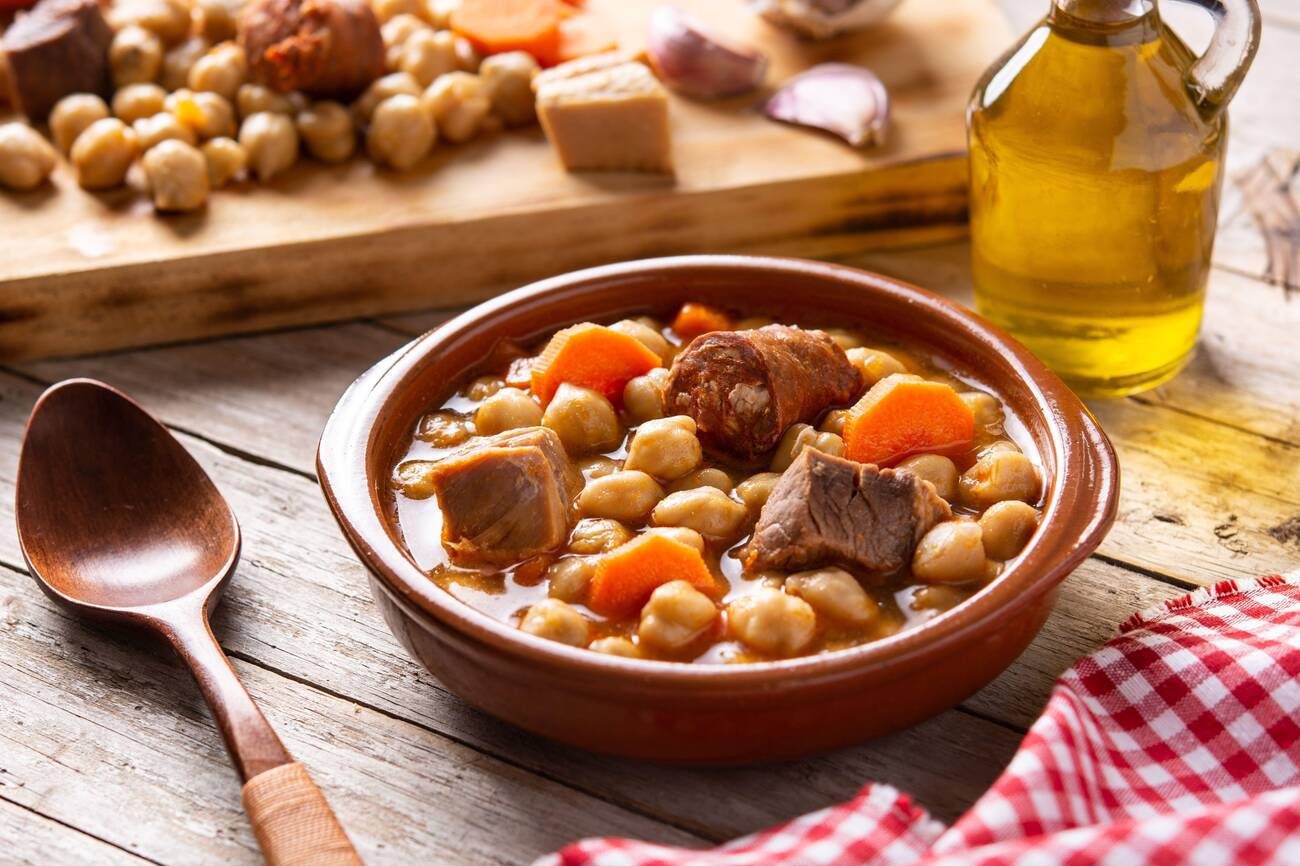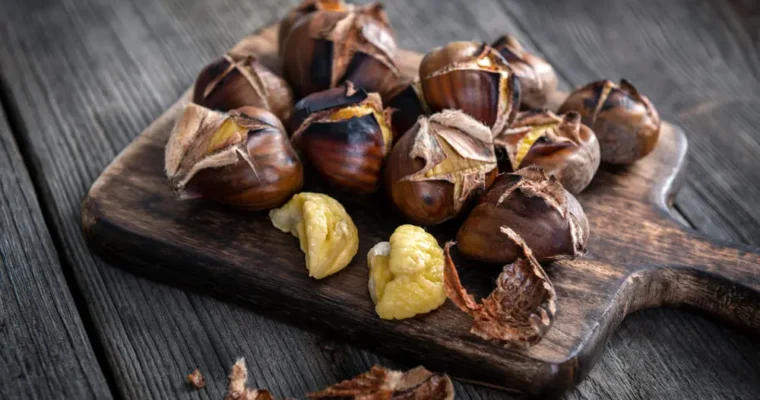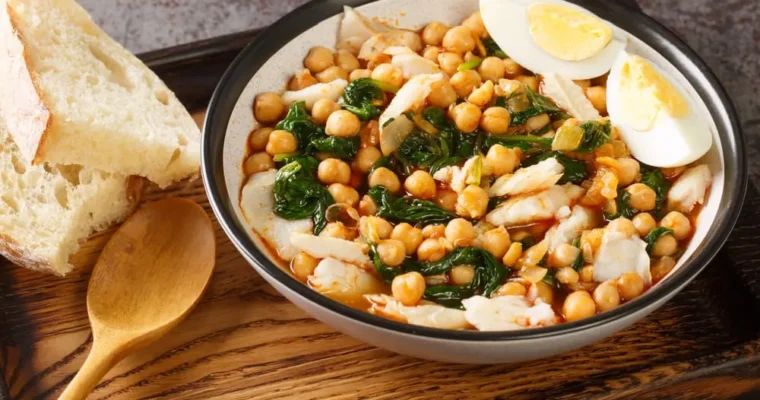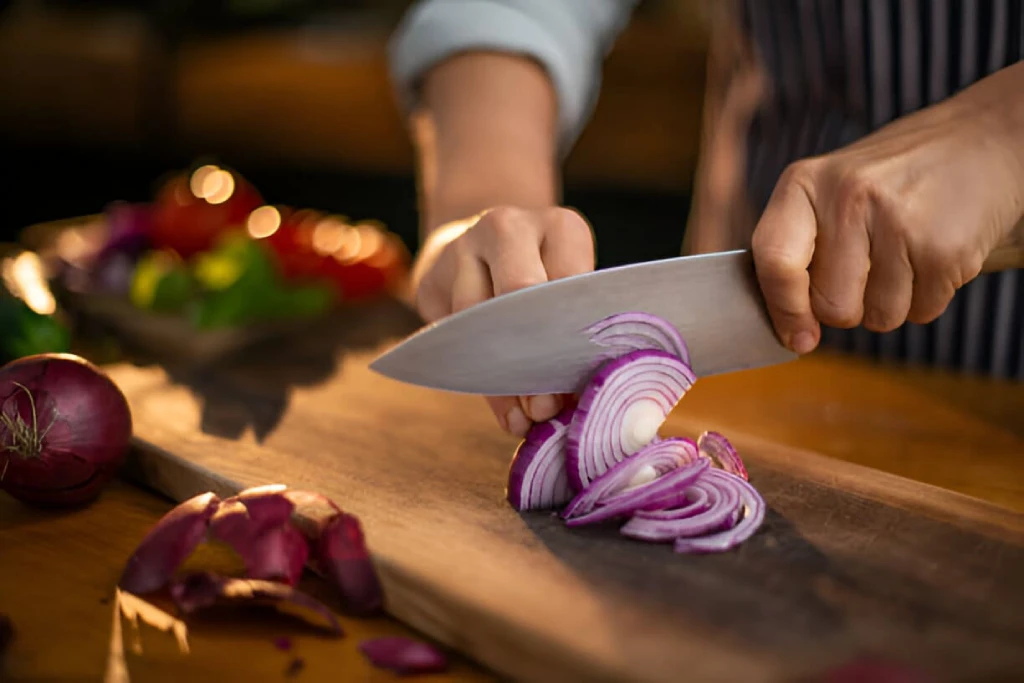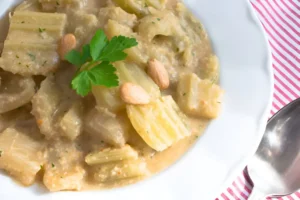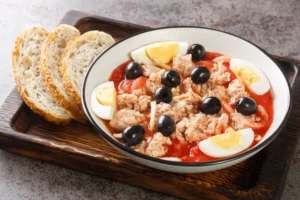Cocido Madrileño is more than just a dish; it’s a culinary symbol of Madrid’s rich history and tradition. This hearty stew has been a staple in Spanish households for centuries, known for its ability to bring families together around the table, especially during colder months. The origins of Cocido Madrileño can be traced back to medieval times, where similar stews were prepared as a way to use up leftover ingredients and stretch meals for large families. Over time, the dish evolved, becoming a beloved part of Spanish gastronomy and a must-try for anyone visiting the capital.
Table of Contents
Key Ingredients of Cocido Madrileño: Selecting the Best
The soul of Cocido Madrileño lies in its ingredients. Traditionally, this dish is made with a variety of meats, chickpeas, and vegetables. Selecting high-quality ingredients is crucial for achieving the authentic flavor that defines this stew.
- Meat: A mix of beef shank, pork belly, chorizo, and morcilla (blood sausage) provides the rich, deep flavor characteristic of Cocido Madrileño. The combination of these meats ensures a perfect balance of textures and flavors.
- Chickpeas: Soaking the chickpeas overnight is essential to achieve the right consistency. They should be tender but not mushy, absorbing the flavors of the broth as they cook.
- Vegetables: Cabbage, carrots, and potatoes are commonly used, adding a subtle sweetness and balancing the richness of the meat.
Step-by-Step: How to Prepare an Authentic Cocido Madrileño
Making Cocido Madrileño is a labor of love. It requires patience and attention to detail, but the results are well worth the effort.
- Preparation: Start by soaking the chickpeas overnight. The next day, drain and rinse them before cooking.
- Cooking the Meat: In a large pot, add the beef shank, pork belly, chorizo, and morcilla. Cover with cold water and bring to a boil. Skim off any foam that forms on the surface.
- Adding Chickpeas and Vegetables: Once the meats have been simmering for about an hour, add the soaked chickpeas, carrots, and potatoes. Continue to cook on low heat, allowing the flavors to meld together.
- Cabbage: In a separate pot, blanch the cabbage until tender, then add it to the main pot in the last 20 minutes of cooking.
- Final Touches: Taste the broth and adjust the seasoning with salt and pepper. Let the stew rest for a few minutes before serving to allow the flavors to settle.
Tips and Tricks for the Perfect Cocido
From my personal experience, the key to a great Cocido Madrileño is patience. Letting the stew cook slowly ensures that all the flavors are well-developed. Additionally, don’t rush the preparation of the ingredients; each step contributes to the final dish. For instance, I always make sure to simmer the meat for long enough to extract the full depth of flavor. Adding the cabbage later in the cooking process also prevents it from becoming too soft and losing its texture.
Regional and Modern Variations of Cocido
While the classic Cocido Madrileño remains a favorite, several regional variations across Spain exist. Some regions might add different types of sausages or use specific local vegetables. In modern kitchens, chefs experiment with lighter versions of the dish, reducing the amount of meat or substituting traditional ingredients for vegetarian alternatives.
How to Serve it: Traditions and Suggestions
Traditionally, Cocido Madrileño is served in three courses, known as “vuelcos”:
- First Course: The broth is often served as a soup with fine noodles or rice.
- Second Course: The chickpeas and vegetables, served on a separate plate.
- Third Course: The meats, served last to be enjoyed with a variety of sauces or simply on their own.
This traditional serving style not only highlights the different components of the dish but also allows diners to savor each element individually.
Related Recipes and Pairings for Cocido Madrileño
Cocido Madrileño pairs beautifully with a variety of Spanish dishes. Here are a few suggestions:
- Tortilla Española: A simple yet flavorful Spanish omelette that complements the richness of the stew.
- Pisto: A Spanish ratatouille that can be served as a side dish or as a topping for the meats.
- Pan Tumaca: Grilled bread rubbed with ripe tomatoes, garlic, and olive oil, perfect for soaking up the broth.
For dessert, consider serving Churros with a rich chocolate dipping sauce, a classic Spanish treat that provides a sweet ending to a hearty meal.
Frequently Asked Questions about Cocido
Q: Can I make Cocido Madrileño in advance? A: Absolutely! Cocido Madrileño often tastes even better the next day as the flavors have more time to meld together. Just be sure to store it in an airtight container in the refrigerator.
Q: Is it possible to make a vegetarian version of Cocido Madrileño? A: Yes, while the traditional recipe is meat-heavy, you can substitute the meats with smoked paprika for depth of flavor and add more vegetables like mushrooms and squash.
Q: What’s the best way to reheat Cocido Madrileño? A: Reheat it gently on the stovetop over low heat, stirring occasionally to ensure even heating. If the stew is too thick, add a little water or broth to reach the desired consistency.
Cocido Madrileño in Spanish Culture
Cocido Madrileño is not just a dish; it’s a cultural icon in Spain, especially in Madrid. It’s a meal that brings people together, whether it’s a family gathering or a festive celebration. The dish embodies the essence of Spanish cuisine simple, hearty, and full of flavor. Preparing Cocido Madrileño is a ritual passed down through generations, and enjoying it is a way to connect with the rich culinary heritage of Spain.
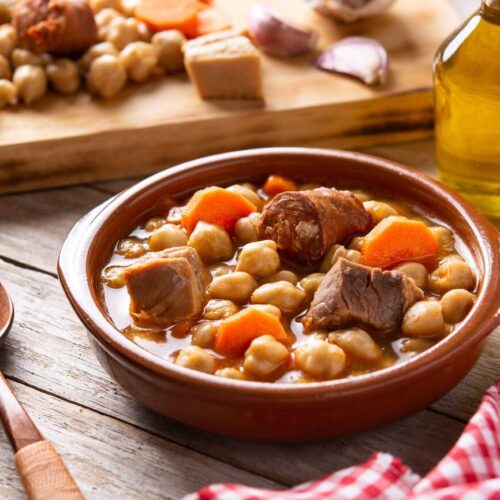
Ultimate Cocido Madrileño Recipe: 5-Step Guide to Spanish Comfort Food
Ingredients
For the chickpeas:
- 1 lb Dried chickpeas, soaked overnight
- 1 Onion, quartered
- 1 Carrot, chopped
- 1 Bay leaf
For the meat and bones:
- 2 lbs Beef brisket or chuck roast
- 1 lb Pork shoulder or boneless ham
- 1 Chorizo
- 1 lb Morcilla (blood sausage)
- 1 lb Beef marrow bones
- 1 Ham hock
- 1 Chicken carcass or a whole chicken
For the vegetables:
- 2 Large potatoes, quartered
- 1 Head of cabbage, quartered
- 2 Carrots, chopped
- 1 Turnip, quartered
- 1 Parsnip, quartered
For the soup:
- Fideo noodles (angel hair pasta)
Instructions
- Soak the chickpeas: Place the dried chickpeas in a large bowl and cover with cold water. Let soak overnight. Drain and rinse.
- Prepare the meat and bones: In a large, heavy-bottomed pot, combine the beef, pork, chorizo, morcilla, beef marrow bones, ham hock, and chicken carcass. Cover with cold water, bring to a boil, then reduce heat and simmer for 1 hour. Skim off any foam that rises to the surface.
- Add chickpeas and vegetables: Add the soaked chickpeas, onion, carrot, and bay leaf to the pot. Simmer for another hour.
- Cook the vegetables: Add the potatoes, cabbage, carrots, turnip, and parsnip to the pot. Cook for an additional hour, or until the vegetables are tender.
- Make the soup: Remove the meat, vegetables, and chickpeas from the pot. Strain the broth and reserve. Cook the fideo noodles according to package directions in the reserved broth.
- Serve: Traditionally, cocido is served in three courses:Sopa de cocido: The noodle soup made with the reserved broth.Garbanzos y verduras: The chickpeas and vegetables served together.Carne: The meats are served separately.
Notes
- Consider toasting chickpeas in a dry skillet before soaking for a richer flavor.
- Cocido is a hearty dish that can be enjoyed alone or with crusty bread.
- Feel free to adjust the ingredients to your liking. Some people add other vegetables like green beans or cauliflower.

